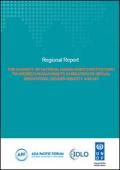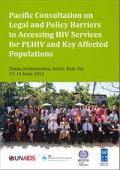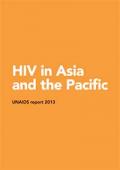What's New
Displaying results 3381 - 3390 of 4914

Resource | Publications,
This Project, Assessing the Capacity of National Human Rights Institutions to Address Human Rights in relation to Sexual Orientation, Gender Identity and HIV (NHRI SOGI Project or the Project), forms part of broader regional collaborative efforts to promote an enabling legal environment for the response to HIV. The NHRI SOGI Project aimed to build understanding of the capacity and response of selected Asian National Human Rights Institutions (NHRIs) to the human rights issues faced by people of diverse sexual orientation and gender identity (SOGI).
In much of Asia, SOGI-related stigma and discrimination strips people of their rights and excludes them from mainstream health programs, public services, and economic opportunity. Stigma and discrimination also have the effect of increasing the acceptability and incidence of violence perpetrated against men and women of diverse SOGI and transgender people. Under these circumstances people of diverse SOGI face ongoing and dehumanizing harm, humiliation and exclusion. Driven underground, people of diverse SOGI are denied the ability to live productive lives as contributing and engaged members of society. Deep set socio-cultural prejudices are exacerbated by punitive and discriminatory legal frameworks, criminalization of same-sex sexual relations in a number of jurisdictions, and law enforcement practices.

Regional Assessment of HIV, STI and Other Health Needs of Transgender People in Asia and the Pacific
Resource | Publications,
Findings from studies conducted in the United States of America and Europe have shown that transgender people are at a significantly higher risk for HIV and sexually transmitted infections (STIs), as compared to gay and heterosexual men.
At the 10th international Congress on AIDS in Asia and the Pacific held in Busan, Republica of Korea, from the 26th to the 30th of August 2011, Republic of Korea, transgender delegates requested the World Health Organization (WHO) to assess the state of transgender health in Asia and the Pacific.
The objectives of this assessment report are (1) to examine the current state of evidence on transgender health in Asia and the Pacific, (2) to understand the current needs and concerns of transgender communities in Asia and the Pacific and, informed by objectives 1 and 2, (3) to make technical recommendations to WHO and Member States regarding transgender health.

Resource | Publications,
It is indeed a great achievement that gender equality is a fundamental element of the constitutions of all countries in South Asia, yet women and girls continue to be discriminated against within their homes, in schools, in the work place, in institutional settings, and even by law. More specifically, discrimination is especially strong among women and girls who are affected by HIV.
This report looks into existing constitutional provisions, laws, and legal mechanisms in Bangladesh, India, Nepal, and Pakistan, and identifies provisions that provide protection or redress for violations of rights at health care settings. While the report focuses specifically on key HIV-affected women, the legal provisions identified also apply to the general population (including marginalized groups, such as disabled and very poor women) whose rights might be violated in health care settings.
The report demonstrates that there are serious gaps in laws to provide protection and redress for violation of rights at health care settings in the four countries under discussion. While the constitutions in all four countries guarantee equality under the law and prohibit discrimination based on sex, there are only a few laws or legal mechanisms that women can use to access justice if these rights have been violated in health care settings.

Resource | Presentations,
Presentation from Expert Meeting on the Implementation of the Outcome of the Asia-Pacific High-level Intergovernmental Meeting on the Assessment of Progress against Commitments in the Political Declaration on HIV/AIDS and the Millennium Development Goals

Resource | Publications,
Transgender people are an integral part of the traditional culture of many countries in Asia and the Pacific and in many places have been accepted into traditional daily life. In September 2012, a regional meeting of transgender advisers and activists adopted a working definition for transgender people in the Asia Pacific context. The adopted definition states that transgender people are: “Persons who identify themselves in a different gender rather than that assigned to them at birth” and may choose to “express their identity differently to that expected of the gender role assigned to them at birth.” Transgender people in the region “often identify themselves in ways that are locally, socially, culturally, religiously, or spiritually defined,” using local terminology and indigenous labels, despite these terms often being derogatory and marginalizing. A report in 2012 documented 50 such different terms for transgender people across 16 countries.
However, acceptance and integration of transgender women and, to a lesser-documented extent, transgender men, into the daily fabric of local community life has diminished in recent times. Many assert that this change has been influenced by ‘western’ ideals. Societal acceptance and support of gender identification and varied sexual orientation has been declining, which is resulting in heightened discrimination of transgender people. Cultural and economic influences from the west have brought stigma, prejudice and discrimination towards those in Asia and the Pacific region who are transgender, along with men who have sex with men (MSM) and women who have sex with women.

Resource | Publications,
This report provides an overview of the Amphetamine-type stimulants (ATS) situation in the region. It outlines several key issues and emerging threats throughout the region and their implications for the neighbouring regions. While the data presented point towards the increased efforts by the countries in the region to tackle the ATS problem, it also highlights the need for continued and joint efforts, both at the national as well as regional levels. It is hoped that this report and the forthcoming national and regional updates, will help in the better understanding of the ATS problem and in designing effective strategies to combat it.

Resource | Publications,
The primary purpose of undertaking this seven-country consultation meeting in April 2013 was to identify the national laws and policies which need review and/or reform, or other programme initiatives which will increase access to rights-respecting HIV services by eliminating real or perceived impediments to delivery of equitable health services to all individuals and communities.
It was intended that countries would develop a measurable and monitorable action plan for undertaking key legal and policy reforms at country level to bring national legislation and policies in line with international good practice relating to human rights and rights-based HIV responses which the United Nations and/or other partners can support in the lead up to the 2015 deadline for achieving global targets and commitments on HIV, including the MDGs, Declaration of Commitment (2006) and Political Declaration (2011), and as part of the ESCAP Framework for regional support to countries.

Resource | Publications,
Across the Asia Pacific region, adolescents aged 10 - 19 years who are living with HIV face unique
challenges as they transition from childhood to adolescence and into adulthood.
This report aims to document and capture some of the experiences of adolescents living with HIV as they disclose their HIV status, deal with life-long antiretroviral treatment (ART), move from pediatric to adult health care services, navigate sexuality and relationships and build their independent lives. It also seeks to offer insights into some of the unique issues adolescents living with HIV face, such as pervasive stigma and discrimination.

Resource | Publications,
The AIDS response in Asia and the Pacific has seen some of the world’s greatest successes. HIV infection rates have fallen in countries across the region in the past decade — significantly in some; a growing number of people are receiving life-saving HIV treatment; domestic financing for AIDS has risen; and, governments across the region are increasingly addressing stigma and discrimination related to HIV and key populations at highest risk.
This report provides an overview of the epidemic and the response in Asia and the Pacific as well as focus on critical progress and challenges in the achievement of the 10 targets, towards getting Asia and the Pacific to zero new infections, zero discrimination and zero AIDS deaths.

Resource | Presentations,
Presentation from Expert Meeting on the Implementation of the Outcome of the Asia-Pacific High-level Intergovernmental Meeting on the Assessment of Progress against Commitments in the Political Declaration on HIV/AIDS and the Millennium Development Goals
11 December 2013, Bangkok, Pullman Bangkok King Power





